| Article ID | Journal | Published Year | Pages | File Type |
|---|---|---|---|---|
| 1827511 | Nuclear Instruments and Methods in Physics Research Section A: Accelerators, Spectrometers, Detectors and Associated Equipment | 2010 | 5 Pages |
Nuclear emulsion films record tracks of charged particles with sub-micron accuracy. The development of fully automatized and DataBase-driven scanning system has made possible the use of nuclear emulsions in large mass detectors. The OPERA experiment, indeed, consists of a hybrid apparatus composed by electronic detectors and lead-emulsion structures (ECC) that make OPERA a large massive (1.25 kt) and high granularity detector. The European Scanning System (ESS), one of the two systems specifically developed for the needs of OPERA, is able to scan emulsions with a speed of 20cm2/h and with position and angular resolution of 0.1μm and 2 mrad. Thanks to these features we are able to follow back charged particles along their trajectories until the location, reconstruction and analysis of neutrino interaction vertices in a quasi-online way.
